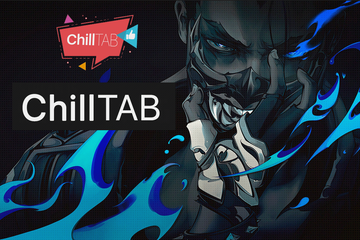The post describes the Chill Tab virus issue affecting web browsers on Mac and provides instructions on removing the annoying redirects and popup alerts.
Update:
| Threat Profile | |
|---|---|
| Name | Chill Tab browser hijacker |
| Category | Mac adware, browser hijacker, redirect virus |
| Related domains | search.chill-tab.com, tab.chill-tab.com |
| Detection | Avast: MacOS:Bundlore-AQ [Adw], BitDefender: Trojan.MAC.Shlayer.F, F-Secure: Malware.OSX/Dldr.Shlayer.frnas, Sophos: Bundlore (PUA), Symantec: OSX/Malcol |
| Symptoms | Redirects web browser to third-party websites, adds sponsored content to search results, causes system slowdown, resists regular removal |
| Distribution Techniques | Malware-riddled app bundles, fake Adobe Flash Player update popups, spam |
| Severity Level | Medium |
| Damage | Unwanted changes of custom browsing settings, privacy issues due to Internet activity tracking, search redirects, redundant ads |
| Removal | Scan your Mac with Combo Cleaner to detect all files related to the browser hijacker. Use the tool to remove the infection if found. |
People are so concerned about privacy these days and can’t stand any interference with their personal space. This issue has partially migrated to the cyber world as the technology moves forward at a gigantic pace. How about one’s web browsing? This thing is intimate to the bone as it holds tons of personally identifiable information and numerous settings that also speak volumes about the user. The violation of these preferences is just as disconcerting as real-life privacy infringements. That's exactly what happens if the Chill Tab virus takes root on a Mac computer. It doesn’t bother asking for the admin’s approval when changing the most important online surfing defaults.
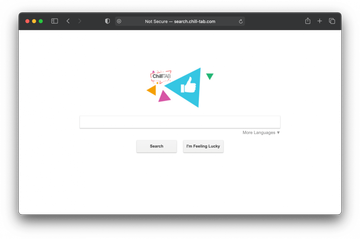

In particular, the Chill Tab nuisance skews such custom browsing settings as the homepage, search and new tab page in Safari, Google Chrome and Mozilla Firefox on a Mac. In the upshot, the victim finds himself or herself in a wicked loop of constantly visiting the search.chill-tab.com or tab.chill-tab.com web page. Although either site is harmless in itself and appears to be some sort of a search provider, it would probably never make it to the user’s browsing history if it weren’t for a sneaky malware attack prior to the emergence of symptoms. This combo of a browser hijacker and persistent adware typically infiltrates Mac machines as part of application bundles. Because the presence of the baddie isn’t clearly disclosed by these installation wizards, people run the risk of unknowingly allowing the setup.

The Chill Tab virus has gained notoriety for its extraordinary persistence and evasion techniques. The affected Mac users find it difficult to spot the associated malicious process in the Activity Monitor, and the unwanted item often hides its footprint from the browser extensions pane as well as the Applications path. It may show up there momentarily when the victim opens either one of these directories, only to mystically vanish right away. Even if found and deleted, which seems to be an instance of great luck, the pest keeps reinstalling itself under a different name to the ‘Users – Shared’ folder. These constant comebacks are a serious hurdle to fixing the problem.
It turns out that Chill Tab meddles with what’s called configuration profiles on a Mac. This technique allows it to hinder removal and minimize the efficiency of tweaking the affected browser settings manually. Whilst device profiles are inherently a prerogative of IT teams who can thereby manage the behavior of Macs on the same enterprise network, adware operators have been exploiting this feature for malicious purposes for quite some time.
Chill Tab virus may re-infect your Mac multiple times unless you delete all of its fragments, including hidden ones. Therefore, it is recommended to download Combo Cleaner and scan your system for these stubborn files. This way, you may reduce the cleanup time from hours to minutes.
Download Now Learn how Combo Cleaner works. If the utility spots malicious code, you will need to buy a license to get rid of it.One more pitfall serious enough to make all Chill Tab victims frown is that the virus keeps track of their online activities. Most users are typically clueless about this shade of the threat because it isn’t manifested in the open. It takes a bit of in-depth observation to notice the tip of the privacy infringement iceberg. Both landing pages backed by this infection return Yahoo Search when you enter a keyword or phrase in them, and the results include ads that match your interests based on the recent browsing history. In fact, Chill Tab surreptitiously monitors which sites you visit, what kind of ecommerce information you look for, which Internet services you prefer, and many other fragments of online behavior that should stay private. This is a goldmine of data which, when compiled and thoroughly processed, allows the malware operators to conduct targeted marketing campaigns or even mastermind phishing attacks with a mind-blowing success rate.
In addition to the browser redirect activity that’s certainly noxious, the Chill Tab virus wreaks more havoc by generating popup notifications almost all the time. One of these is a recurrent dialog window recommending the user to install Chill Tab - whatever that should mean, given that the perpetrating program is already there anyway. This popup says, “Are you sure you want to install the extension Chill-Tab?” The culprit must be trying to add another unwanted helper object to Safari via this technique. Hopefully to no avail.
Another symptom is that Safari will be randomly starting up and displaying a popup that says, “Scanning for browser updates”. This will be followed by an onset of another window saying, “Your browser is now up to date!” Next, the user may see the above-mentioned request to install Chill Tab extension. Ultimately, this onslaught turns into an iterative display of nag screens mixed up with browser rerouting. Such a state of things, obviously, isn’t on any Mac user’s wish list, to put it mildly. The Chill Tab (search.chill-tab.com / tab.chill-tab.com) virus should be exterminated as soon as possible. The methodology of this cleanup is what the following sections will cover in detail.
Chill Tab virus manual removal for Mac
The steps listed below will walk you through the removal of this malicious application. Be sure to follow the instructions in the specified order.
Expand the Go menu in your Mac’s Finder bar and select Utilities as shown below.
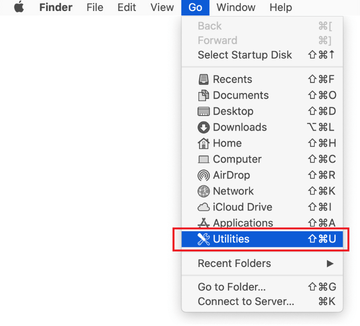
Locate the Activity Monitor icon on the Utilities screen and double-click on it.
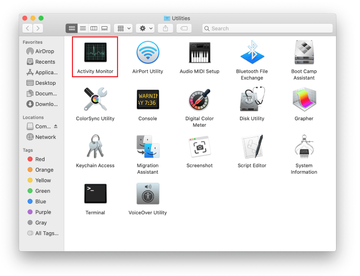
In the Activity Monitor app, look for Chill-Tab or another process that appears suspicious. To narrow down your search, focus on unfamiliar resource-intensive entries on the list. Keep in mind that its name isn’t necessarily related to the way the threat is manifesting itself, so you’ll need to trust your own judgement. If you pinpoint the culprit, select it and click on the Stop icon in the upper left-hand corner of the screen.
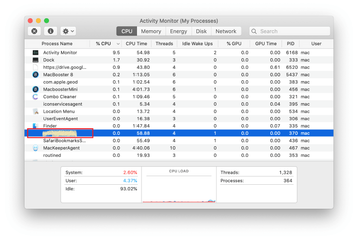
When a follow-up dialog pops up asking if you are sure you want to quit the troublemaking process, select the Force Quit option.
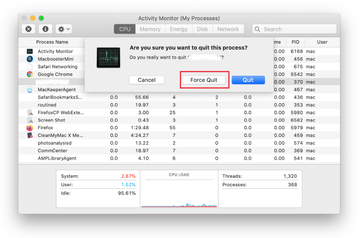
Click on the Go menu icon in the Finder again and select Go to Folder. You can as well use the Command-Shift-G keyboard shortcut.

Type /Library/LaunchAgents in the folder search dialog and click on the Go button.
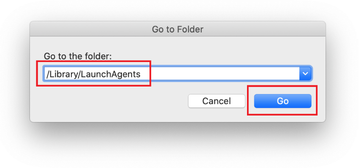
Examine the contents of the LaunchAgents folder for dubious-looking items. The objects known to be associated with Chill Tab virus are as follows: tab.chill-tab.com.update.plist, tab.chill-tab.com.AppRemoval.plist, tab.chill-tab.com.download.plist, tab.chill-tab.com.ltvbit.plist, com.Tab.chill-tab.com.agent.plist, com.SoftwareUpdater.agent.plist.
Be advised that the names of files spawned by malware may give no clear clues that they are malicious, so you should look for recently added entities that appear to deviate from the norm. As an illustration, here are several examples of LaunchAgents related to mainstream Mac infections: com.pcv.hlpramc.plist, com.updater.mcy.plist, com.avickUpd.plist, and com.msp.agent.plist. If you spot files that don’t belong on the list, go ahead and drag them to the Trash.
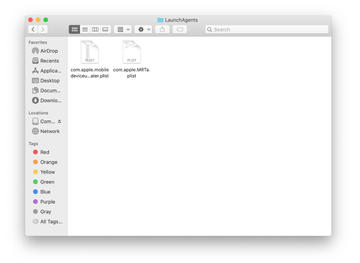
Use the Go to Folder lookup feature again to navigate to the folder named ~/Library/Application Support (note the tilde symbol prepended to the path).
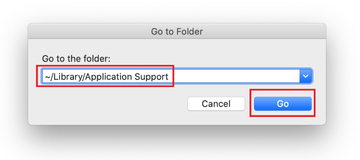
When the Application Support directory is opened, identify recently generated suspicious folders in it and send them to the Trash. A quick tip is to look for items whose names have nothing to do with Apple products or apps you knowingly installed. A few examples of known-malicious folder names are tab.chill-tab.com, SoftwareUpdater, and IdeaShared.
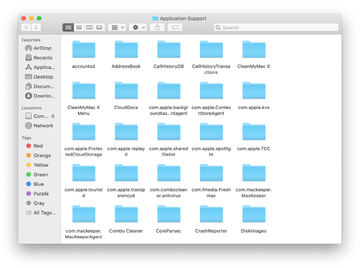
Enter ~/Library/LaunchAgents string (don’t forget to include the tilde character) in the Go to Folder search area.
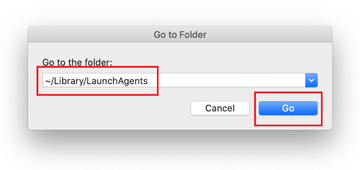
The system will display LaunchAgents residing in the current user’s Home directory. Look for dodgy items related to Chill Tab virus (see logic highlighted in subsections above) and drag the suspects to the Trash.
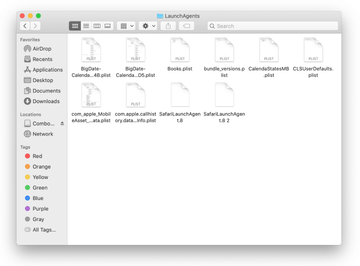
Type /Library/LaunchDaemons in the Go to Folder search field.
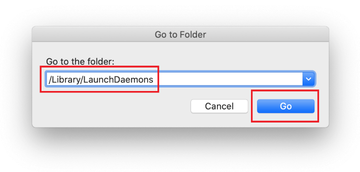
In the LaunchDaemons path, try to pinpoint the files the malware is using for persistence. Several examples of such items cropped by Mac infections are com.pplauncher.plist, com.startup.plist, and com.ExpertModuleSearchDaemon.plist. Delete the sketchy files immediately.
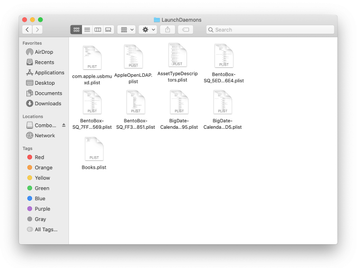
Click on the Go menu icon in your Mac’s Finder and select Applications on the list.

Find the entry for Chill Tab (Chill-Tab) or another app that clearly doesn’t belong there and move it to the Trash. If this action requires your admin password for confirmation, go ahead and enter it.
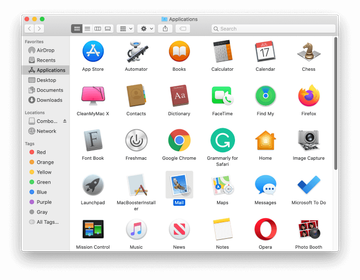
Expand the Apple menu and select System Preferences.
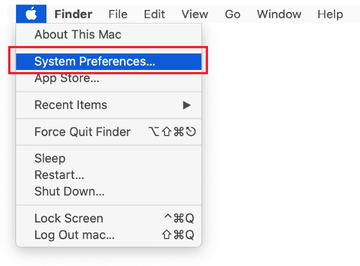
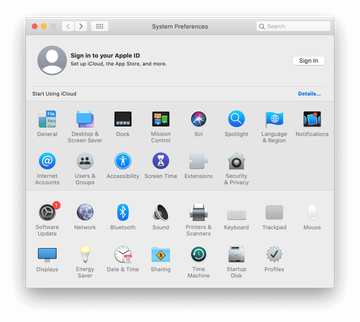
Proceed to Users & Groups and click on the Login Items tab.
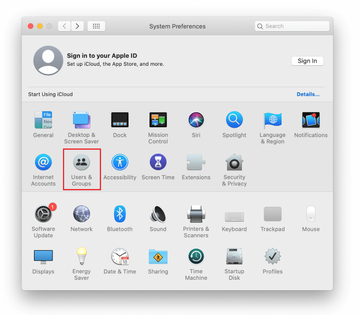
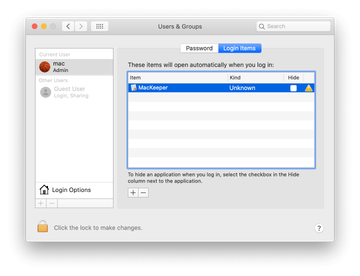
Now select Profiles under System Preferences. Look for a malicious item in the left-hand sidebar. Several examples of configuration profiles created by Mac adware include TechSignalSearch, MainSearchPlatform, AdminPrefs, and Chrome Settings. Select the offending entity and click on the minus sign at the bottom to eliminate it.
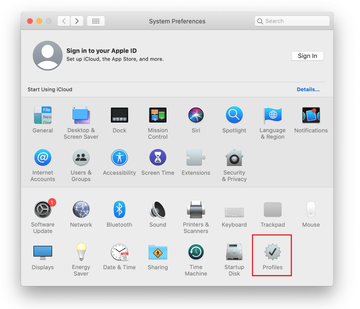
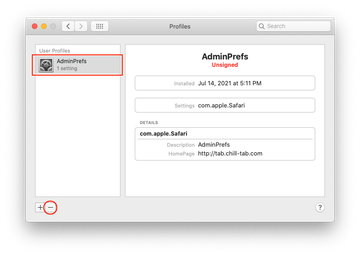
Get rid of Chill Tab virus in web browser on Mac
To begin with, the web browser settings taken over by the Chill Tab virus should be restored to their default values. Although this will clear most of your customizations, web surfing history, and all temporary data stored by websites, the malicious interference should be terminated likewise. The overview of the steps for completing this procedure is as follows:
- Remove Chill Tab virus from Safari
Open the browser and go to Safari menu. Select Preferences in the drop-down list.
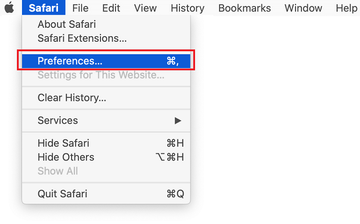
Once the Preferences screen appears, click on the Advanced tab and enable the option saying “Show Develop menu in menu bar”.
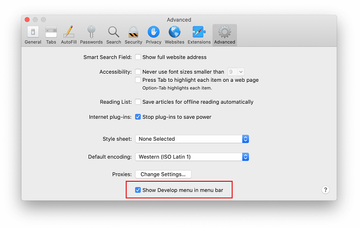
Now that the Develop entry has been added to the Safari menu, expand it and click on Empty Caches.
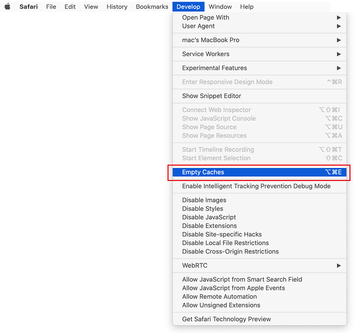
Now select History in the Safari menu and click on Clear History in the drop-down list.
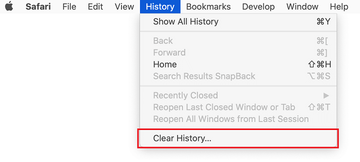
Safari will display a dialog asking you to specify the period of time this action will apply to. Select all history to ensure a maximum effect. Click on the Clear History button to confirm and exit.

Go back to the Safari Preferences and hit the Privacy tab at the top. Find the option that says Manage Website Data and click on it.

The browser will display a follow-up screen listing the websites that have stored data about your Internet activities. This dialog additionally includes a brief description of what the removal does: you may be logged out of some services and encounter other changes of website behavior after the procedure. If you’re okay with that, go ahead and click on the Remove All button.
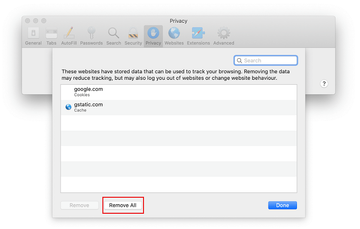
Restart Safari
- Remove Chill Tab in Google Chrome
Open Chrome, click the Customize and control Google Chrome (⁝) icon in the top right-hand part of the window, and select Settings in the drop-down
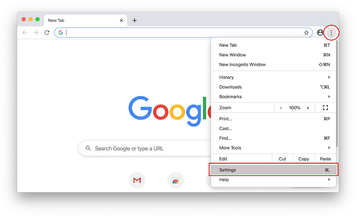
When on the Settings pane, select Advanced
Scroll down to the Reset settings section.
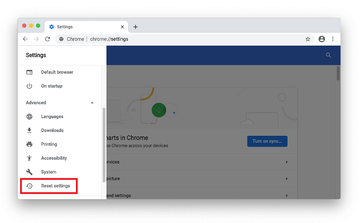
Confirm the Chrome reset on a dialog that will pop up. When the procedure is completed, relaunch the browser and check it for malware activity.
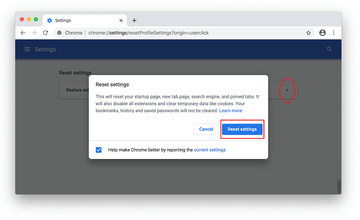
- Remove Chill Tab from Mozilla Firefox
Open Firefox and go to Help – Troubleshooting Information (or type about:support in the URL bar and press Enter).
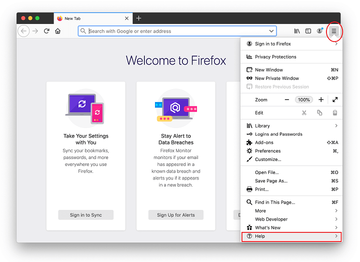

When on the Troubleshooting Information screen, click on the Refresh Firefox button.
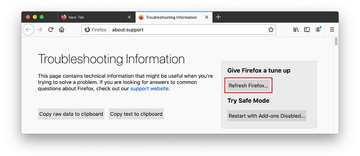
Confirm the intended changes and restart Firefox.
Use automatic tool to uninstall Chill Tab malware from your Mac
The Mac maintenance and security app called Combo Cleaner is a one-stop tool to detect and remove Chill Tab virus. This technique has substantial benefits over manual cleanup, because the utility gets hourly virus definition updates and can accurately spot even the newest Mac infections.
Furthermore, the automatic solution will find the core files of the malware deep down the system structure, which might otherwise be a challenge to locate. Here’s a walkthrough to sort out the Chill Tab issue using Combo Cleaner:
Download Combo Cleaner installer. When done, double-click the combocleaner.dmg file and follow the prompts to install the tool onto your Mac.
By downloading any applications recommended on this website you agree to our Terms and Conditions and Privacy Policy. The free scanner checks whether your Mac is infected. To get rid of malware, you need to purchase the Premium version of Combo Cleaner.
Open the app from your Launchpad and let it run an update of the malware signature database to make sure it can identify the latest threats.
Click the Start Combo Scan button to check your Mac for malicious activity as well as performance issues.
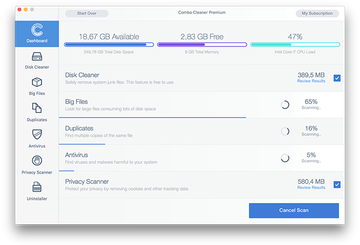
Examine the scan results. If the report says “No Threats”, then you are on the right track with the manual cleaning and can safely proceed to tidy up the web browser that may continue to act up due to the after-effects of the malware attack (see instructions above).
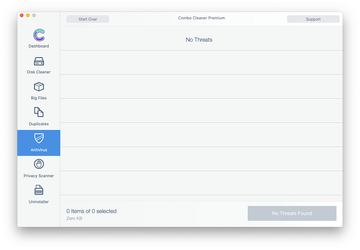
In case Combo Cleaner has detected malicious code, click the Remove Selected Items button and have the utility remove Chill Tab threat along with any other viruses, PUPs (potentially unwanted programs), or junk files that don’t belong on your Mac.
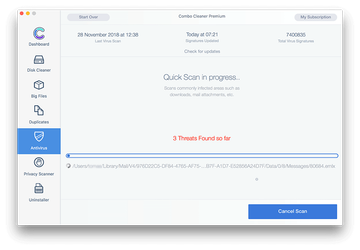
Once you have made doubly sure that the malicious app is uninstalled, the browser-level troubleshooting might still be on your to-do list. If your preferred browser is affected, resort to the previous section of this tutorial to revert to hassle-free web surfing.
FAQ
What is Chill Tab?
Chill Tab, also known as Chill-Tab, is a potentially unwanted Mac app manifesting itself as an intrusive browser extension. It pretends to enhance one’s web search experience by providing a shortcut to access an all-in-one information lookup source. Although it claims to only change the new tab setting in Safari, Google Chrome, or Mozilla Firefox, the actual tweaks extend further to the default search and homepage configuration. All of these preferences are replaced with search.chill-tab.com or tab.chill-tab.com page. The search requests entered in these bogus providers return Yahoo Search results. Therefore, the virus takes over a significant portion of the victim’s Internet traffic without their awareness and approval.
Although Chill Tab has an “official” web page briefly describing its alleged functionality, very few people install it via that channel. Instead, the application mostly comes bundled with legit freeware so that users are unaware that they are additionally getting the extra item. As part of this furtive infiltration, the infection obtains permissions to manage the browsing settings on a host Mac. This explains why it can easily modify the user’s online defaults to set in motion fraudulent redirect activity.
When running in a web browser, Chill Tab also displays strange and annoying popups that say, “Your browser is now up to date” and “Are you sure you want to install the extension Chill-Tab?” The former notification encourages the victim to click OK to continue, which can be a disguised authorization of follow-up adware attacks. The latter dialog often appears after the user manually removes the malicious extension from the affected browser. Due to deep penetration of the underlying harmful code into the plagued system, the reinstall attempts will keep occurring in this case until the threat is properly eradicated from the Mac rather than from the web browser only.
Is Chill Tab dangerous?
This Mac infection is mostly a nuisance as it makes victims recurrently visit unwanted sites. The popups it triggers and the ads it embeds in the landing pages add another layer of frustration to the user’s web surfing experience. Being constantly faced with these symptoms of the Chill Tab virus is definitely a drag. Plus, it prevents users from disabling the naughty extension in the regular way and the problem reoccurs shortly after such attempts. Is it dangerous, though? It can be.
The biggest risk is about privacy. It’s common knowledge that most adware apps gather information on victims’ web browsing, and Chill Tab follows suit. It records the Internet navigation history and search keywords. On top of that, it may even log keystrokes and stealthily make screenshots at random. Once browser hijack campaign operators get hold of these details, they may sell it to advertisers or cybercriminals. A scenario of Chill Tab authors abusing this personally identifiable data to their own advantage is plausible, too.
How do I get rid of Chill Tab?
Unlike regular Mac software, Chill Tab resists the standard uninstall and reapplies the unsolicited browser changes if you try to get rid of it this way. Moreover, it may conceal its files from the places users would normally peek into, such as the Activity Monitor, Applications, and the Extensions list in the web browser that’s acting up. Therefore, to remove Chill Tab from your Mac permanently, you should think outside the box. The full cleaning instructions are listed in the guide above. In a nutshell, here are the steps to follow:
- Find the malicious process (named “Chill-Tab” or random-looking entry) in the Activity Monitor and force-quit it.
- Go to /Library/LaunchAgents, ~Library/LaunchAgents, and ~Library/Application Support folders, look for the following items in there and drag them to the Trash if found:
- tab.chill-tab.com.update.plist
- tab.chill-tab.com.AppRemoval.plist
- tab.chill-tab.com.download.plist
- tab.chill-tab.com.ltvbit.plist
- com.Tab.chill-tab.com.agent.plist
- com.SoftwareUpdater.agent.plist
- tab.chill-tab.com
- SoftwareUpdater.
- Go to Applications, spot Chill Tab (or other suspicious app that installed itself behind your back), and move it to the Trash.
- Empty the Trash.
- Go to the Login Items and minus out the Chill-Tab entry.
- Delete the Chill Tab extension in the browser (Safari, Chrome, or Firefox). If the removal option is grayed out, reset the browser to its original defaults.
- Restart your Mac.
Keep in mind that fixing the browser alone doesn’t address the issue. To ensure the right effect, you need to take your efforts further and eliminate the additional components of the offending program. In case the Chill Tab virus keeps coming back after this procedure has been applied, consider using an automatic security solution for Mac to detect and terminate the infection.
Why does Chill Tab keep installing?
The entirety of Chill Tab’s persistence mechanisms have yet to be studied in depth. It’s known for a fact, though, that the infection meddles with the list of startup apps and the user profiles on a contaminated Mac. This way, the malicious code is configured to run at boot time, and the newly added user account with administrator privileges reinstalls the culprit after the victim attempts to remove the unwanted app along with the rogue browser extension. Furthermore, the repeatedly enabled program tends to switch names so that the manual repair turns into a wicked “catch me if you can” game.
How do I remove threats from my Mac?
There are two techniques to stop malicious activity on your Mac: manual and automatic. While both pursue the same goal, the gap between the implementation of each is significant. The process of removing a threat by hand requires troubleshooting skills, a good deal of research, and sometimes quite a bit of intuition. To put it plainly, you will have to check a series of system folders for potentially unwanted items and eliminate the suspects. These locations typically include LaunchAgents, LaunchDaemons, Application Support, Profiles, and Login Items.
Automatic removal allows you to skip the hard part. A cleaning tool worth its salt traverses all common paths parasitized by Mac malware, detects harmful items based on signature logic and behavioral analysis, and quarantines the detected files to defang the offensive code. This approach is much easier and saves you a lot of time, but it may require a subscription.
Regardless of your preferred removal method, bear in mind that some after-effects of the attack may stick around until you address them manually. For instance, if a strain of adware has replaced your browsing defaults such as the search engine and homepage, you will additionally need to specify these settings anew.
